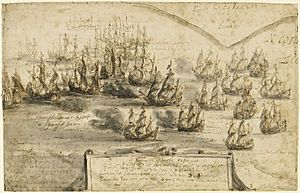Action of 12 March 1672 facts for kids
Quick facts for kids Action of 12 March 1672 |
|||||||
|---|---|---|---|---|---|---|---|
| Part of the Franco-Dutch War | |||||||
 Holme's attack on the Smyrna Fleet, off Beachy Head, 12 March 1672 |
|||||||
|
|||||||
| Belligerents | |||||||
| Commanders and leaders | |||||||
| Strength | |||||||
| 9 warships | 5 warships 66 merchantmen |
||||||
| Casualties and losses | |||||||
| 1 ship disabled (Saint Michael) and severe damage to the other ships | 1 warship lost (Klein Hollandia) 4 small merchantmen captured |
||||||
The Action of 12 March 1672 was a sea battle that happened just before the Third Anglo-Dutch War officially began. It was a fight between ships from England and the Dutch Republic. The English fleet, led by Sir Robert Holmes and Sir Frescheville Holles, tried to capture a group of Dutch merchant ships. These ships were part of the Smyrna convoy and were protected by five Dutch warships. Even though the battle happened before war was declared, it made it clear that a bigger conflict was coming. England officially declared war on the Dutch Republic five days later, on March 17, 1672.
The Surprise Attack
Sir Robert Holmes was sailing near the Isle of Wight with his squadron of five English warships. They spotted a large group of Dutch merchant ships, about 50 of them, sailing in a convoy. These merchant ships were carrying valuable goods from Smyrna.
When the English ships got closer, Holmes ordered the Dutch convoy's leader, Captain De Haaze, to come aboard his ship. De Haaze refused this order. In response, the English ship Saint Michael fired its cannons at De Haaze's ship. The Dutch ship fired back, and a full battle began.
Captain De Haaze was killed during the fight, but his crew bravely kept fighting. Holmes continued the battle until sunset, but he couldn't capture any of the Dutch ships. His own squadron had taken a lot of damage.
The Fight Continues
When the sun rose the next day, the battle started again. Four more English warships, which had not joined the fight the day before, now entered the action. After another full day of fighting, the Dutch commander, Cornelis Evertsen, managed to lead 62 of the merchant ships to safety.
During the battle, the Dutch lost one warship and only four smaller merchant ships. Two of these captured merchant ships were valuable. The English ships were badly damaged, and one ship was unable to move. The Dutch warship Klein Hollandia, which the English ship Gloucester had captured, later sank off Eastbourne.
The Ships That Fought
Here are the details of the warships that took part in this battle. These facts come from historical records about British warships from that time.
| Vessel | Guns |
|---|---|
| Saint Michael | 90 |
| Resolution | 70 |
| Cambridge | 70 |
| Gloucester | 62 |
| York | 60 |
| Fairfax | 60 |
| Diamond | 48 |
| Success | 32 |
| Vessel | Guns |
|---|---|
| Vlissingen | 50 |
| Utrecht | 48 |
| Klein Hollandia | 44 |
| Dordrecht | 44 |
| Delft | 36 |

